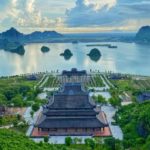Tam Chuc Pagoda sits in Ba Sao town, Kim Bang district, Ha Nam province, and is currently the largest pagoda in the world, located within the Tam Chuc heritage area, which covers a total area of over 5,100 hectares, including both land and the lake surface.
The architecture of the pagoda is a harmonious combination of Vietnamese Buddhist style and unique elements from the Buddhist cultures of many countries such as India, Nepal, Thailand, etc. Tam Chuc Pagoda honors many influential Zen masters who have contributed to the development of Buddhism in Vietnam, including Master Dat Ma, Zen Master Nguyen Minh Khong, Zen Master Khuong Viet, Venerable Thich Thanh Tu, and Zen Master Do Phap Thuan.
Spring, especially the first few months of the lunar new year, from the 10th day of the first lunar month until the end of March, is the best time to visit Tam Chuc Pagoda in Ha Nam. This is the time when festivals take place, with pleasant and cool weather. During this time, visitors not only enjoy the beautiful scenery but also have the opportunity to perform Buddhist rituals and pray for wealth and luck.
Thuy Dinh Guest House
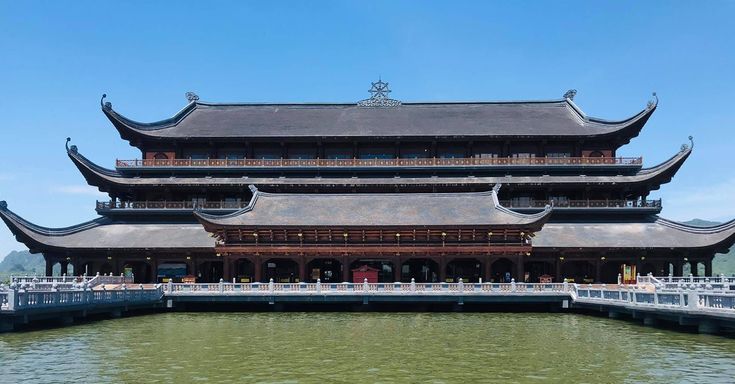
Thuy Dinh Guest House
When visiting Tam Chuc Pagoda, visitors will first come across Thuy Dinh Guest House. This is the place for visitors to check-in, buy tickets for boat tours, and explore the interior space with images of Tam Chuc Pagoda.
Inside Thuy Dinh, the space is solemn and respectful. It displays vivid paintings using LED lights, depicting the overall scenery of the Tam Chuc spiritual tourism area, creating an impressive experience for anyone who visits.
Tam Quan Gate
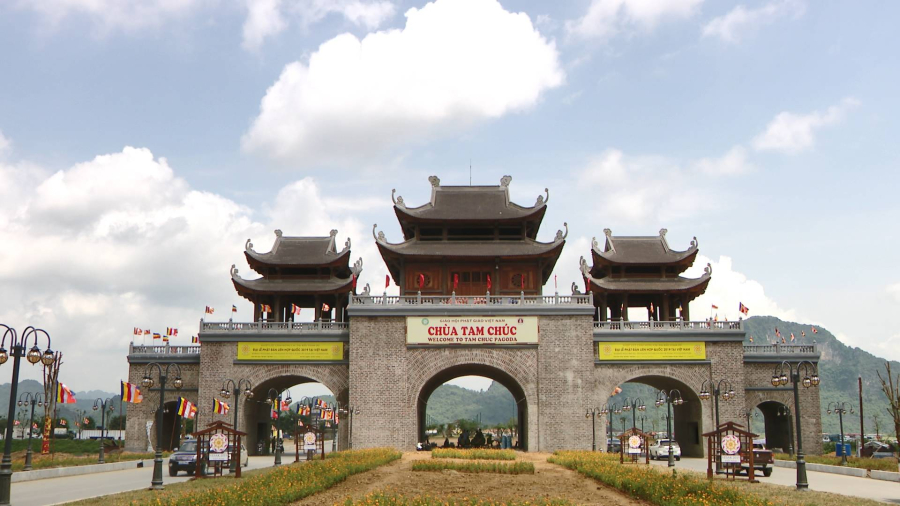
Tam Quan Gate at Tam Chuc Pagoda
Tam Quan Gate of Tam Chuc Pagoda is a grand structure. It is located right in front of the boat pier and electric vehicle pick-up point. Although motorbike taxis are not allowed to operate in this area, visitors often encounter them, perhaps because some drivers choose to “bend the rules.” Their presence becomes convenient, especially during the New Year holidays when a large number of people come here to visit, causing a high demand that electric vehicles and boats cannot serve in a timely manner, resulting in overload.
On both sides of Tam Quan Gate, there are wide paths leading to the main shrines of the pagoda. When walking from Tam Quan Gate to Quan Am Shrine, you will pass by the Kinh Column Garden with 32 stone columns, also known as the Column Garden. Inspired by the national treasure – the kinh column of Nhat Tru Pagoda in Hoa Lu, Ninh Binh, the Kinh Column Garden at Tam Chuc Pagoda is also built on a grand scale. Each column weighs about 200 tons, carved from Thanh Hoa blue stone. These columns are uniquely designed with a lotus-shaped base, a hexagonal column body with exquisite carved sutras, and a column top in the shape of a lotus bud.
Grand and Majestic Three Shrine Buildings
Tam Chuc Pagoda is where three solemn shrine buildings are gathered, with each shrine dedicated to a Buddha statue and carrying deep spiritual meanings. Tam The Shrine, Phap Chu Shrine, and Quan Am Shrine all have a common special feature: four exquisite relief sculptures made from volcanic rocks from Indonesia.
In each Buddha shrine, the relief sculptures not only showcase sculptural art but also tell stories about the life of the Buddha. The path to the Shrineways contains high steps, with the magnificent natural scenery of waterfalls and diverse flower gardens on both sides.
These stones are crafted in Indonesia and then brought to Tam Chuc Pagoda, where they are assembled into complete walls. The traces of the volcanic rocks can be clearly seen when observed.
Quan Am Shrine
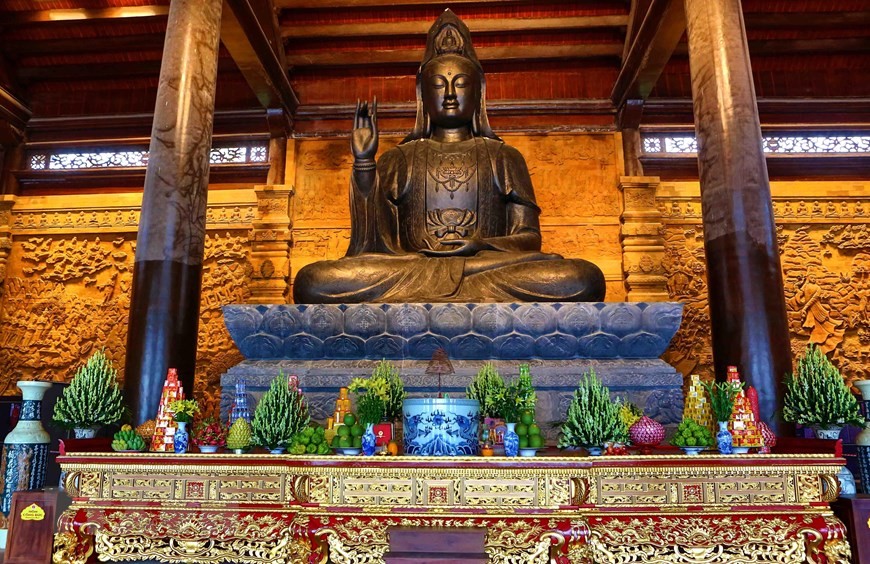
Quan Am Shrine
– Quan Am Shrine is where the Buddha with a Thousand Hands and a Thousand Eyes is worshipped, and it is the first destination after passing through the Tam Quan Gate.
Phap Chu Shrine
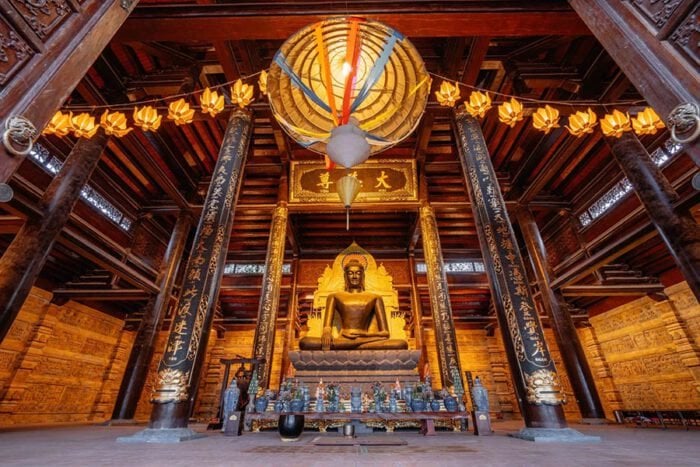
Phap Chu Shrine
– In Phap Chu Shrine, visitors can admire the largest Thich Ca Buddha statue in Southeast Asia, weighing 200 tons. The shrine is designed with a two-story dome roof, 31m high, and a 3,000m2 floor. A complex and detailed stone painting reflecting Tam Chuc Pagoda is displayed in front of the shrine entrance. The Thich Ca Buddha statue made of solid copper is placed at the center of the Shrine.
Tam The Shrine
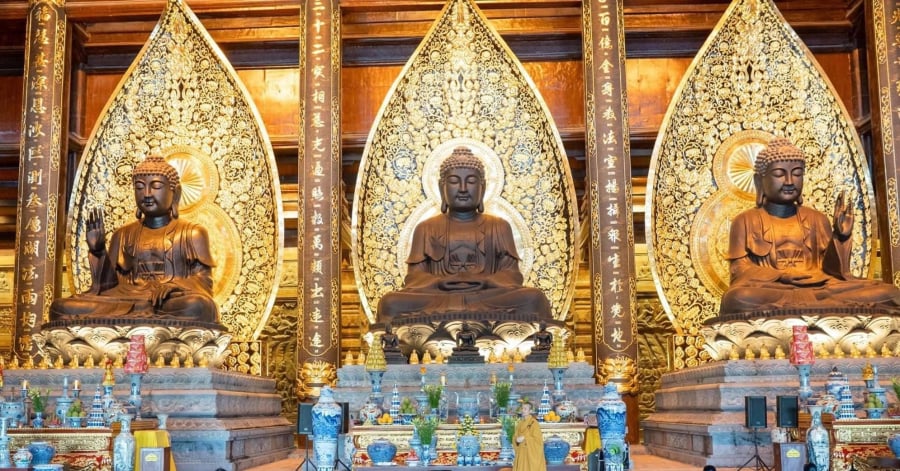
Tam The Shrine
– Tam The Shrine displays three black copper Buddha statues, representing the past, present, and future. Each Buddha statue is accompanied by a relief sculpture of a lotus leaf.
In front of the shrine courtyard, there is an impressive 4m tall black copper relief sculpture, depicting sacred places of Vietnam and the teachings of Zen Master Nguyen Minh Khong, the patriarch of Bai Dinh Pagoda. Tam Chuc Pagoda is also planning to restore the four great spiritual powers, an indispensable part of spiritual traditions.
Ngoc Pagoda – The Sky Altar of Tam Chuc Pagoda
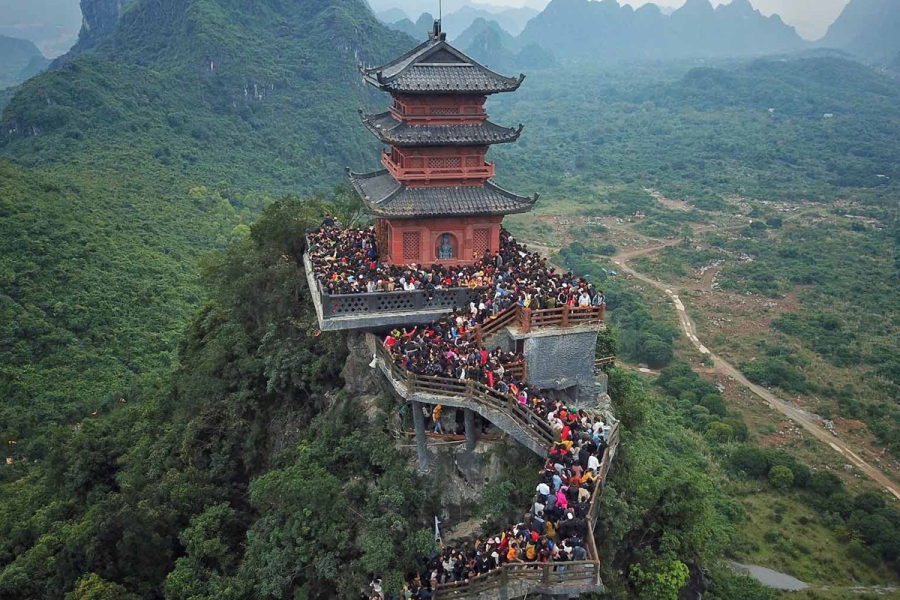
Ngoc Pagoda
After passing through the main shrine area, the journey continues with a challenging road leading to Ngoc Pagoda. This is a journey that not everyone can complete because from the Tam Quan Gate, the road becomes more rugged and steep, increasing the difficulty for anyone who wants to set foot in this pagoda. Although Ngoc Pagoda occupies only a floor area of 13m2, it impresses with its weight of 2,000 tons, as the entire structure is made of granite, without the use of concrete.
Tam Chuc Pagoda is not only famous for its architecture and history but also preserves a precious and rare moonstone, weighing 5.5kg and valued at over 600,000 USD, equivalent to about 14 billion VND. This moonstone, named “The Moon Puzzle,” is a part of the moon that fell into the Sahara Desert thousands of years ago and was discovered in 2017. On October 19, 2018, at an auction by RR Auction in Boston, USA, Xuan Truong Company from Ninh Binh successfully repurchased this meteorite and it is currently displayed at Tam Chuc Pagoda, adding to the precious collection of the pagoda.
Tam Chuc Communal House
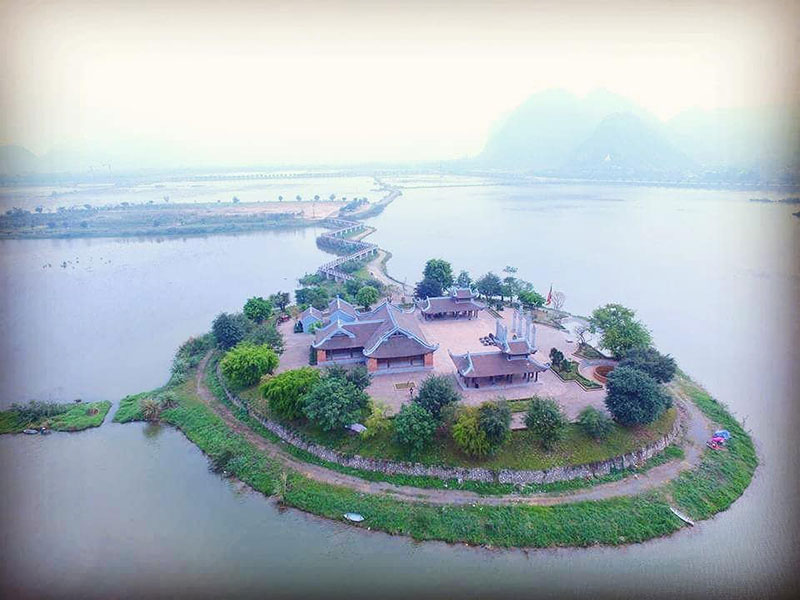
Tam Chuc Communal House
Tam Chuc Communal House, dedicated to Queen Dinh Duong Thi Nguyet, is a mystical destination located on the picturesque Luc Ngan Lake. The road to Tam Chuc Communal House is a meandering bridge, crossing the clear water, connecting the shore to this ancient pagoda, along with the majestic scenery of six small mountains emerging from the lake, creating a unique natural complex. Luc Ngan Lake is not only the largest natural lake in the country but also the habitat of many underwater species, vivid to the extent that every movement under the lake is part of a mysterious historical and natural story. When the lotus season arrives, the tranquility and beauty of the lotus flowers on the lake surface resemble heavenly flowers, giving visitors the feeling of stepping into a separate world, peaceful and magical.

























